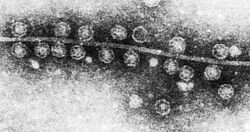Biology:Enterobacteria phage Qbeta
| Enterobacteria phage Qbeta | |
|---|---|

| |
| Virus classification | |
| Group: | Group IV ((+)ssRNA)
|
| Family: | |
| Genus: | |
| Species: | Bacteriophage Qβ
|
| subspecies | |
| |
Bacteriophage Qβ is a single-stranded RNA bacteriophage which infects bacteria that have F-pili, most commonly Escherichia coli. Its linear genome is packaged into an icosahedral capsid with a diameter of 28 nm.[1] Qβ enters its host cell after binding to the side of the F-pilus.[2]
Genetics
The genome of Qβ is ~4,217nt, depending on the source which sequenced the virus. Qβ has been isolated all over the world, multiple time, with various subspecies that code for near identical proteins but can have very different nucleotide sequences.
The genome has three open reading frames that encode four proteins: the maturation/lysis protein A2; the coat protein; a readthrough of a leaky stop codon in the coat protein, called A1; and the β-subunit of an RNA-dependent RNA-polymerase termed the replicase. The genome is highly structured, regulating gene expression and protecting itself from host RNases.[2]
Maturation/lysis protein A2
All single-stranded RNA phages encode a maturation protein, whose function is to bind the host pilus and the viral RNA.[3] The maturation protein is named thus, as amber mutants in the maturation protein are unable to infect their host, or are 'immature.' For the related ssRNA bacteriophage MS2, the maturation protein was shown to be taken up by the host along with the viral RNA and the maturation protein was subsequently cleaved.[4]
In MS2 the maturation protein is called the A protein, as it belongs to the first open reading frame in the viral RNA. In Qβ the A protein was initially thought to be A1, as it is more abundant within the virion and is also required for infection.[5] However, once the sequence of Qβ was determined, A1 was revealed to be a readthrough of the leaky stop codon.
A2 is the maturation protein for Qβ and has an additional role of being the lysis protein.[6]
The mechanism of lysis is similar to that of penicillin; A2 inhibits the formation of peptidoglycan by binding to MurA, which catalyzes the first enzymatically committed step in cell wall biosynthesis.[7]
Coat protein/A1
There are ~178 copies of the coat protein and/or A1 in the capsid.
RNA-dependent RNA-polymerase
The RNA polymerase that replicates both the plus and minus RNA strands is a complex of four proteins: the catalytic beta subunit (replicase, P14647) is encoded by the phage, while the other three subunits are encoded by the bacterial genome: alpha subunit (ribosomal protein S1), gamma subunit (EF-Tu), and delta subunit (EF-Ts).[8]
The structure of Qbeta RNA replicase has been solved (PDB: 3AGP, 3AGQ). The two EF proteins serve as a chaperone for both the replicase and the RNA product.[9] In fact, pure Qbeta polymerase is not soluble enough to be produced in large quantities, and a fusion protein constructed from the replicase and the two EF subunits is usually used instead. The fusion can function independently of ribosomal protein S1.[10]
Experiments
RNA from Bacteriophage Qβ was used by Sol Spiegelman in experiments that favored faster replication, and thus shorter strands of RNA. He ended up with Spiegelman's Monster, an minimal RNA chain of only 218 nucleotides that can be replicated by Qβ replicase.[11]
References
- ↑ "Asymmetric cryo-EM structure of the canonical Allolevivirus Qβ reveals a single maturation protein and the genomic ssRNA in situ". Proceedings of the National Academy of Sciences of the United States of America 113 (41): 11519–11524. October 2016. doi:10.1073/pnas.1609482113. PMID 27671640.
- ↑ 2.0 2.1 "Ongoing phenotypic and genomic changes in experimental coevolution of RNA bacteriophage Qβ and Escherichia coli". PLoS Genetics 7 (8): e1002188. August 2011. doi:10.1371/journal.pgen.1002188. PMID 21829387.
- ↑ "Protein-RNA Interactions in the Single-Stranded RNA Bacteriophages". Sub-Cellular Biochemistry (Springer Singapore) 88: 281–303. 2018. doi:10.1007/978-981-10-8456-0_13. ISBN 9789811084553. PMID 29900502.
- ↑ "Stages in phage R17 infection. V. Phage eclipse and the role of F pili". Virology 45 (3): 615–28. September 1971. doi:10.1016/0042-6822(71)90176-0. PMID 4108185.
- ↑ "Possible origin of a minor virus specific protein (A1) in Q-beta particles". Nature 234 (50): 204–6. September 1971. doi:10.1038/newbio234204a0. PMID 5288806.
- ↑ "Overproduction of bacteriophage Q beta maturation (A2) protein leads to cell lysis". Cell 33 (3): 877–85. July 1983. doi:10.1016/0092-8674(83)90030-2. PMID 6871998.
- ↑ "Structures of Qβ virions, virus-like particles, and the Qβ-MurA complex reveal internal coat proteins and the mechanism of host lysis". Proceedings of the National Academy of Sciences of the United States of America 114 (44): 11697–11702. October 2017. doi:10.1073/pnas.1707102114. PMID 29078304.
- ↑ "Single-stranded RNA phages. Chapter 15". The Bacteriophages (Second ed.). Oxford University Press. 2006. pp. 175–196. ISBN 978-0195148503.
- ↑ "Assembly of Q{beta} viral RNA polymerase with host translational elongation factors EF-Tu and -Ts". Proceedings of the National Academy of Sciences of the United States of America 107 (36): 15733–8. September 2010. doi:10.1073/pnas.1006559107. PMID 20798060.
- ↑ "Functional Qbeta replicase genetically fusing essential subunits EF-Ts and EF-Tu with beta-subunit". Journal of Bioscience and Bioengineering 101 (5): 421–6. May 2006. doi:10.1263/jbb.101.421. PMID 16781472.
- ↑ Dawkins, Richard; Wong, Yan (2016). The Ancestor’s Tale. ISBN 978-0544859937.
External links
Wikidata ☰ Q4840022 entry

